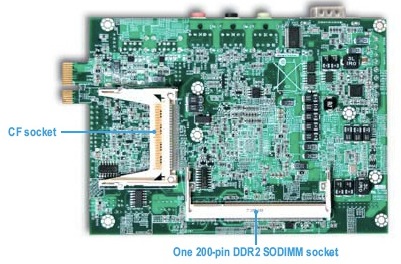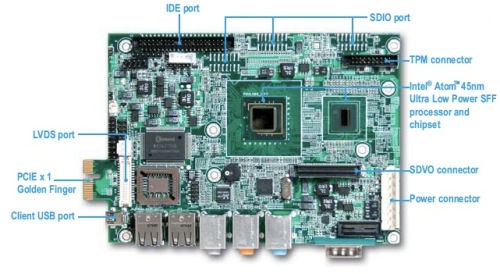Atom-based ECX board runs Linux
May 15, 2008 — by LinuxDevices Staff — from the LinuxDevices Archive — 8 views Portwell has announced a single-board computer (SBC) using Intel's Centrino Atom chipset and ECX (embedded compact extended) form factor. Targeting applications such as kiosks and digital signage, the PEB-2736 supports dual displays, has a CompactFlash slot, and accepts an optional TPM (trusted platform module), says Portwell.
Portwell has announced a single-board computer (SBC) using Intel's Centrino Atom chipset and ECX (embedded compact extended) form factor. Targeting applications such as kiosks and digital signage, the PEB-2736 supports dual displays, has a CompactFlash slot, and accepts an optional TPM (trusted platform module), says Portwell.
(Click here for a larger view of Portwell's PEB-2736)
Intel's ECX form factor made its debut in 2006, and has been used ever since by Advantech, iBASE, and Portwell. It is touted by Intel as providing fanless capabilities, PCI Express connectivity, and dual independent displays, all in a relatively small 5.75 x 4.1-inch footprint.
The PEB-2736 is designed to employ Intel's Atom processors, though Portwell does not specify which ones. Atom processors range from the 800GHz Z540 to the 1.9GHz Z540Atom Z510. Other products announced to date have concentrated on the 1.1GHz Z510 and 1.6GHz Z530 parts, perhaps due to Intel's long-term availability commitment to these models.

The bottom of Portwell's PEB-2736 has slots for RAM and flash memory
In any case, total power consumption of the board is under 10 Watts, according to the company. The PEB-2736 naturally uses Intel's US15W SCH (system controller hub), and it accepts up to 1GB of memory in a 200-pin SODIMM socket. The SODIMM socket is on the bottom of the board, shown above, along with a CompactFlash socket.

The top of the PEB-2736
On top of the board (above), the Atom and US15W can be found toward the middle. Around the edge, starting at top left and moving clockwise, there's a 44-pin IDE port, three connectors for optional SDIO daughtercards, and a connector for the optional Infineon TPM (trusted platform module). The lower half of the board features a power connector plus SDVO and LVDS connectors.
Facilitating the connection of dual independent displays, the SDVO connector supports a daughtercard that adds a second LVDS output, DVI, or VGA. A so-called “golden finger” connector that provides x1 PCI Express expansion, likely the route to adding Ethernet capabilities.

Real-world connectors include six channels of audio output
The lower edge of the board, seen above, houses the PEB-2736's “real-world” interfaces, in the form of four USB ports, an RS232 port, and 5:1 audio output. Analog audio signals are apparently provided via six discrete 3.5mm jacks, which would make the PEB-2736 an interesting candidate for media server applications, even though these were not heralded by Portwell.
Features and specifications provided by Portwell for the PEB-2736 include:
- Processor — Intel Atom (clock speeds not specified)
- Memory — up to 1GB of DDR2 RAM, via 200-pin SODIMM socket
- Storage — Type II CompactFlash slot
- I/O:
- 4 x USB host (edge connectors)
- 1 x USB client (type B connector)
- 6 x analog audio outputs (5:1 surround sound)
- 1 x RS232
- LVDS port
- SDVO port (supports VGA/DVI/LVDS daughtercard)
- 3 x SDIO (pin headers)
- 1 x GPIO (pin header)
- 1 x TPM connector (pin header)
- 4 x USB host (edge connectors)
- Expansion:
- PCI Express x1 via “golden finger”
- CompactFlash Type II socket
- PCI Express x1 via “golden finger”
- Dimensions — 5.75 x 4.1 inches
- Operating temperature — 0 to 60 deg. C (-40 to 85 deg. C “by request”)
The PEB-2736 runs either Linux or Windows. Pricing and availability information were not supplied.
This article was originally published on LinuxDevices.com and has been donated to the open source community by QuinStreet Inc. Please visit LinuxToday.com for up-to-date news and articles about Linux and open source.